Feline leukemia virus (FeLV) is one of the most common infectious diseases in cats, being encountered by two to three percent of all cats in the U.S. Leukemia is also the second leading killer of cats, behind only trauma. The disease kills 85 percent of persistently infected cats within three years of diagnosis. Leukemia can also commonly cause anemia or lymphoma and other deadly infections.
But leukemia isn’t necessarily a death sentence for your cat. In fact, 70 percent of cats are able to resist or eliminate the virus on their own. Prevalence of leukemia has also decreased significantly in the past 25 years thanks to the development of an effective vaccine.
With that outlook in mind, it’s a good idea to familiarize yourself with the causes, symptoms, and treatment of feline leukemia should your pet ever come down with the illness.
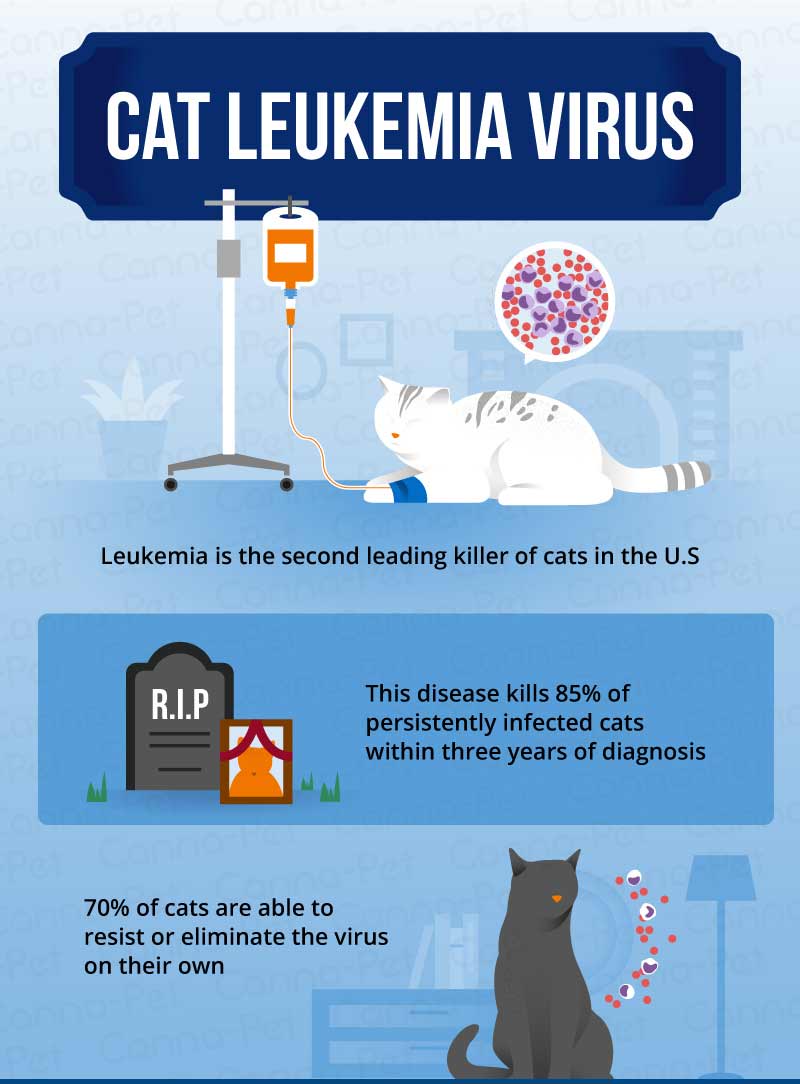
How do cats get Feline Leukemia Virus?
Feline leukemia suppresses a cat’s immune system. The virus affects a cat’s blood, and can cause various other blood diseases. Because it suppresses a cat’s immune system, it makes it harder for the cat to protect against infection from bacteria, fungi or other viruses.
Feline leukemia is actually contagious, as cats persistently infected with FeLV can infect other cats. The virus is transmitted through direct, cat-to-cat contact. Leukemia is shed in saliva, nasal secretions, urine, feces and the milk of infected cats.
The virus can be transferred through a bite wound, mutual grooming, and occasionally through the use of shared litter boxes and feeding dishes. The virus can also be transferred from a mother to her kittens, either before birth or during nursing.
The disease cannot be transmitted to people or other animals, including dogs. It only affects cats. The virus cannot survive long outside of a cat’s body, only lasting for a few hours. Seemingly healthy cats can become infected and transfer the virus.
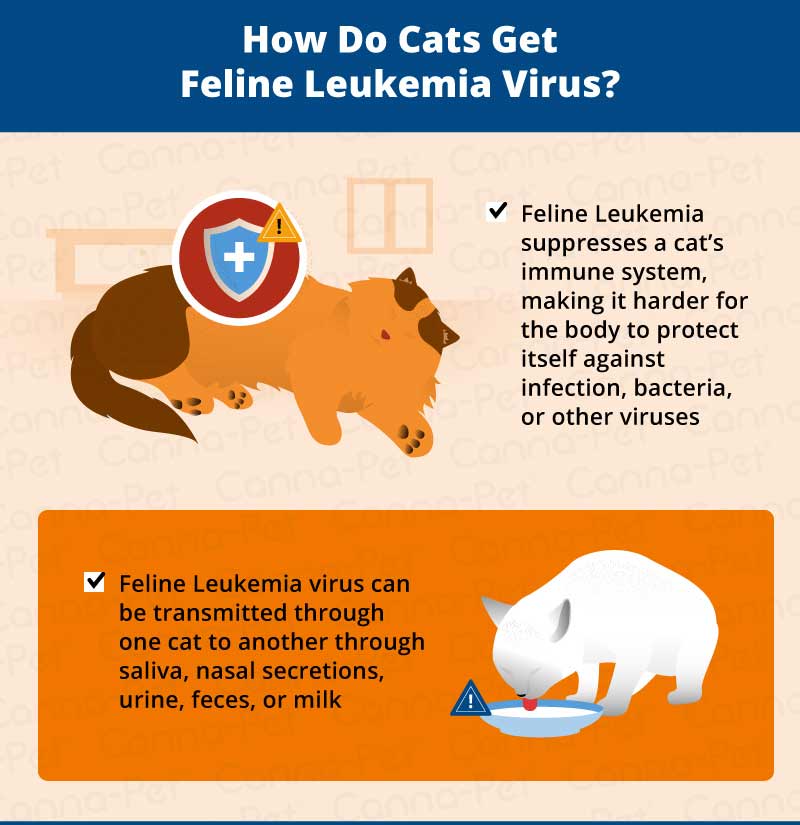
Which cats are most at risk for Feline Leukemia Virus?
The cats at greatest risk for contracting leukemia are those that live with an infected cat, or a cat with an unknown infection status. For this reason, it’s important to get a new cat tested before you expose it to your other cats. Kittens and young adult cats are more susceptible to the virus than older cats, as a resistance appears to develop with age.
The risk is very low for indoor cats, while outdoor cats and cats in multi-cat households are more at risk, especially if they share water, food dishes, and litter boxes. Just three percent of cats in single-cat households have the virus, but that number rises for cats that go outside. As mentioned previously, the prevalence has decreased thanks to vaccines and reliable testing.
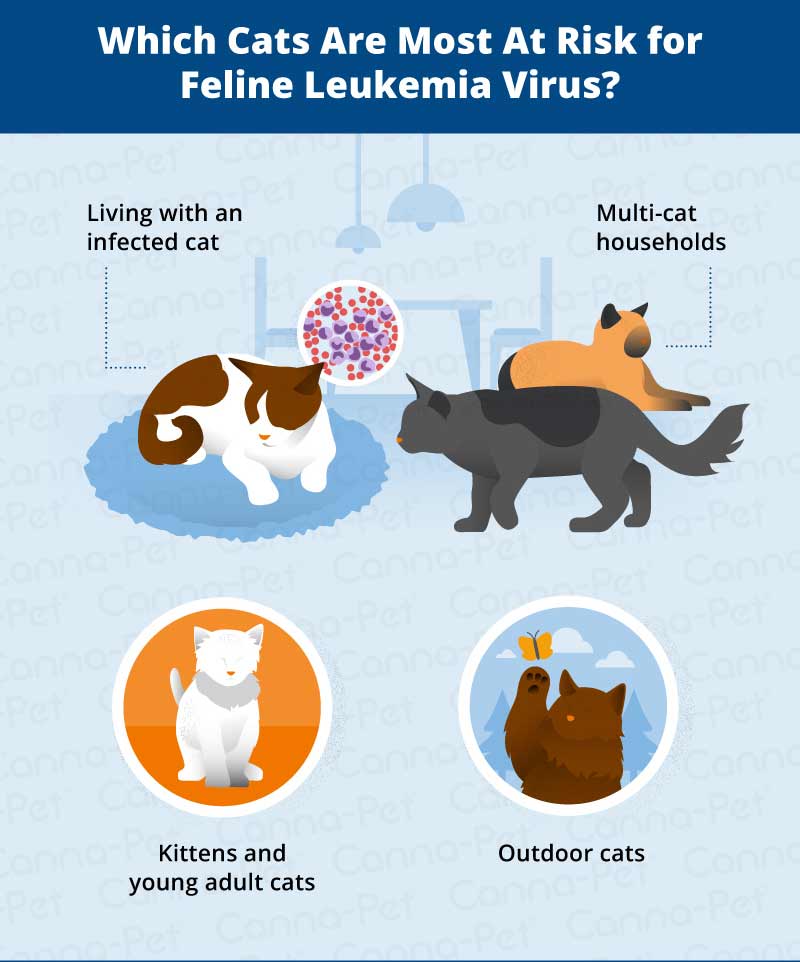
Symptoms of Feline Leukemia Virus
Signs can vary greatly because the feline leukemia virus can affect almost any organ system in the body. Infected cats will often show one or more of the following feline leukemia symptoms:
- Pale gums and other mucous membranes
- Yellow color in the mouth and whites of eyes
- Enlarged lymph nodes
- Bladder, skin, or upper respiratory infections
- Kidney disease
- Anemia
- Weight loss and/or loss of appetite
- Poor coat condition
- Recurring or chronic illness
- Progressive weakness and lethargy
- Fever
- Persistent diarrhea
- Breathing difficulty
- Reproductive problems like sterility in unspayed female cats
- Stomatitis – oral disease that includes ulceration of gingiva
- Seizures, behavior changes, and other neurological disorders
- A variety of eye conditions
- Cancer of the lymphatic system
Because feline leukemia virus attacks the immune system, it hinders a cat’s ability to protect itself against other infections, leaving it vulnerable to other illnesses. Common bacteria, viruses, and even fungi that wouldn’t normally affect a healthy cat can cause severe illness in cats with the leukemia virus. The secondary infections are often what becomes lethal to the cat.
During early stages of infection, cats will often exhibit no signs of the disease at all. But the cat’s health will deteriorate over time, taking weeks, months or even years. The progression can be quick and consistent or go in repeating cycles of illness and relative health. Many cats will not develop long-term complications, and some cats can eliminate the infection entirely before they ever become sick from the virus. Sometimes the virus can even “hide” in a cat’s bone marrow, becoming difficult to detect until later in the cat’s life when it starts to cause problems.
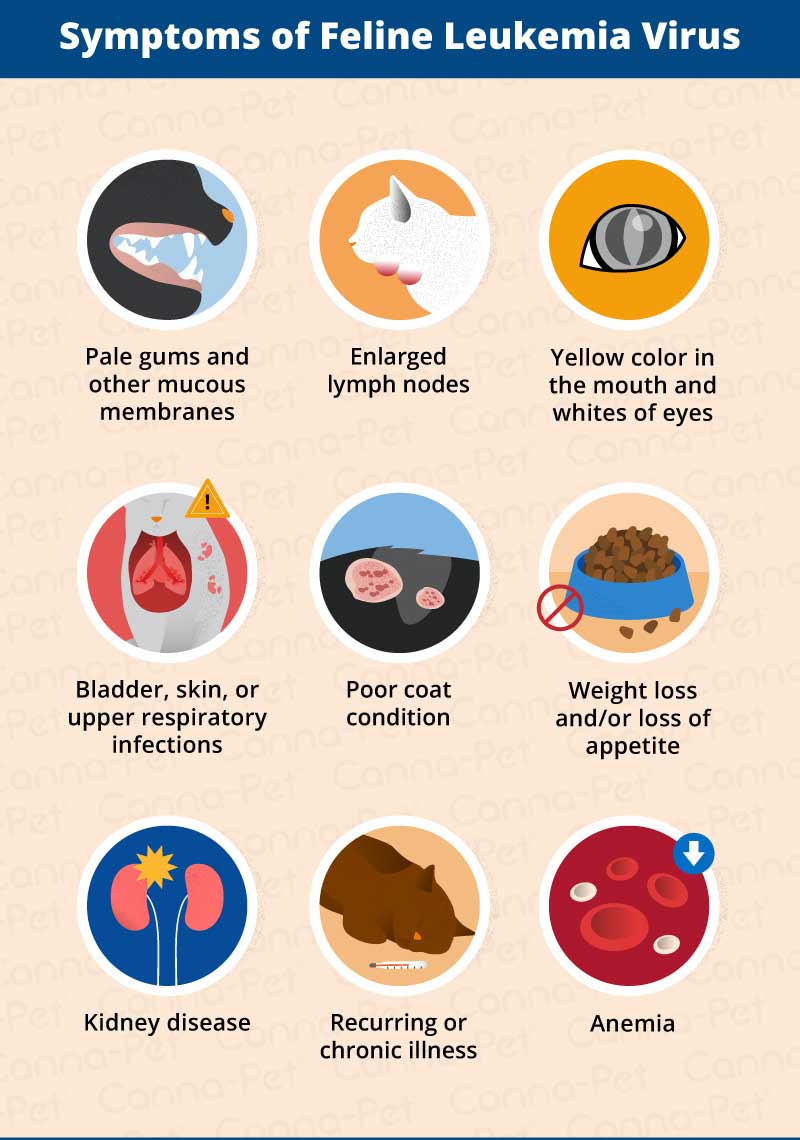
How is Feline Leukemia Virus in cats diagnosed?
Diagnosis of the feline leukemia virus is complicated because there are several stages of the disease and because every cat handles the infection differently. For most cats, a blood test will be conducted to detect the disease, but for others, bone marrow must be examined to confirm the infection. Some cats can test positive for the infection when they are younger, then test negative later in life if their immune systems were able to eliminate the infection.
And because the virus progresses through stages, some will test negative early and positive later on. It will often take multiple tests to confirm the diagnosis.
The first blood test (ELISA) detects leukemia by identifying the proteins associated with the virus in a cat’s blood. It is a highly sensitive test and can identify the virus very early. This test is conducted in the veterinarian’s office and detects the presence of free particles that are commonly found in the bloodstream during the early and late stages of infection.
Some cats can clear the infection in as little as a few months and test negative. A second blood test (IFA) is used to detect the progressive phase of the infection. It does this by detecting the presence of the virus within a cat’s white blood cells, which is an indication of a more advanced infection. Cats with positive results in this test are unlikely to clear the virus from their system. This test is conducted at a diagnostic laboratory, rather than at your veterinarian’s office. In general, these cats tend to have a poor long-term prognosis.
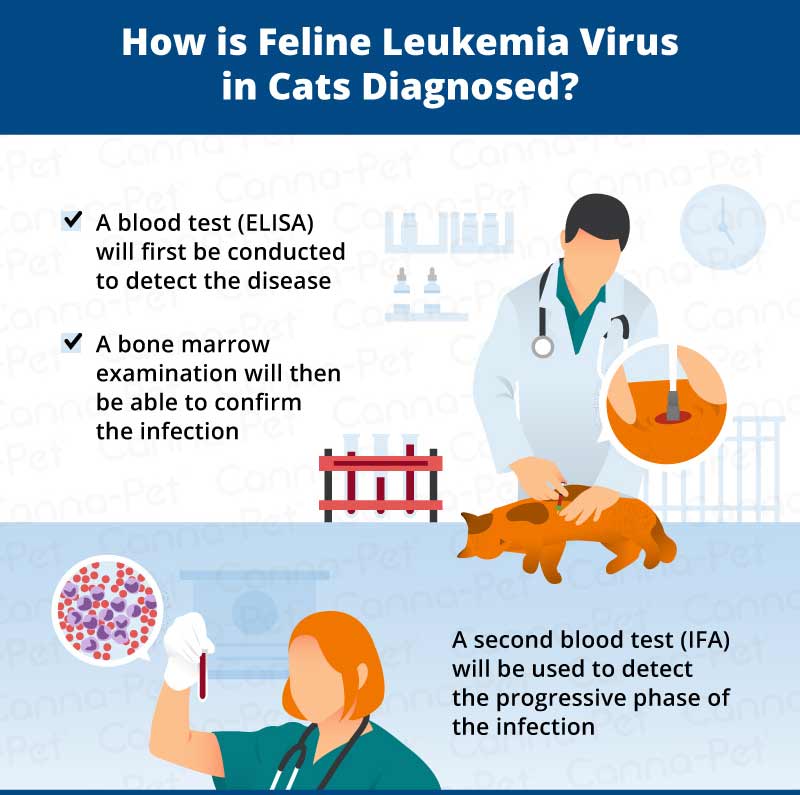
How is Feline Leukemia Virus treated?
Eighty-five percent of cats that are persistently infected with the disease die from it within three years of diagnosis. But with regular check-ups at your veterinarian, including twice-a-year physicals, and routine testing, you can keep your cat feeling well and prevent secondary infection.
While there is not currently a cure for feline leukemia virus, the secondary infections can often be treated as they appear. Cats with bone marrow leukemia or widespread lymphoma will have a grave prognosis. Even with aggressive treatment, some cats can still die from the virus.
There is no medication that can eliminate the virus, but many medications are available to help with symptoms. Steroids, antiviral drugs, chemotherapy and blood transfusions are commonly prescribed to treat feline leukemia. Steroids are used to decrease the number of cancerous lymphocytes in the blood, but they also leave the cat vulnerable to other diseases because they can weaken a cat’s immune system.
An antiviral can reduce the amount of virus present in the cat’s blood and are easier on the cat’s body than chemotherapy. The risks and benefits of the treatments must be weighed, while keeping in mind that they cannot get rid of the virus, but can put a cat into remission. Veterinarians generally will prescribe antibiotics for any bacterial infections or perform a blood transfusion in an instance of severe anemia.
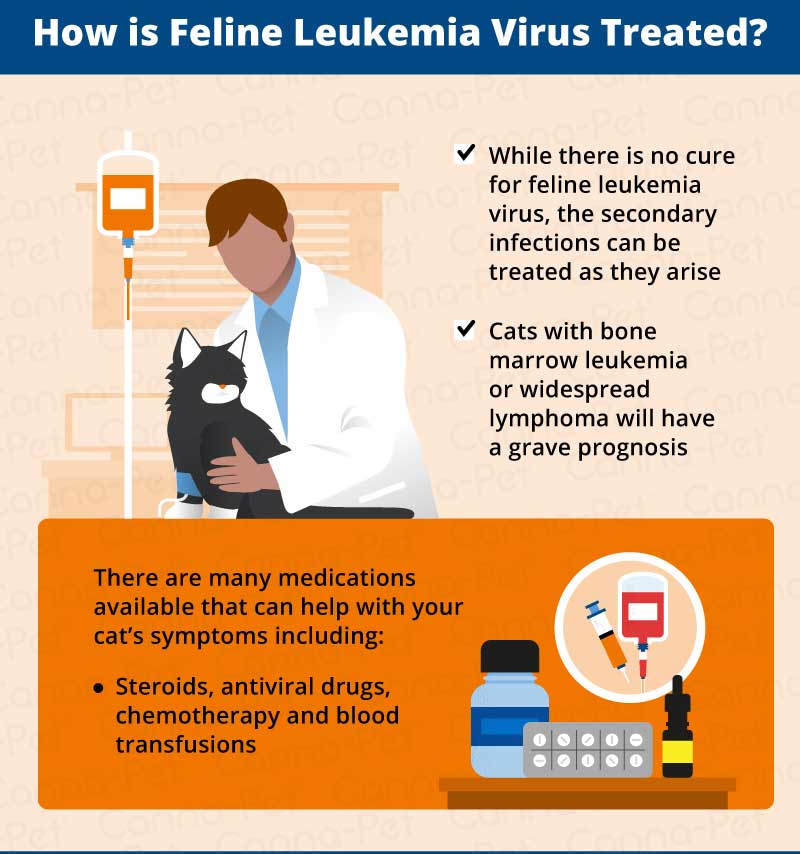
What can I do to prevent my cat from contracting Feline Leukemia Virus?
The only sure way to protect cats from developing feline leukemia is to prevent their exposure to infected cats. It is recommended to keep cats indoors away from other potentially infected cats. If you continue to let your cat outside, try to supervise them or place them in a secure enclosure.
If you get a new cat, make sure to get him tested for feline leukemia before introducing him to your home and other cats (if you have any). If you have an infected cat, make sure to not share food and water bowls or litter boxes with your other cats. Make sure to test your other cats when you have an infected cat.
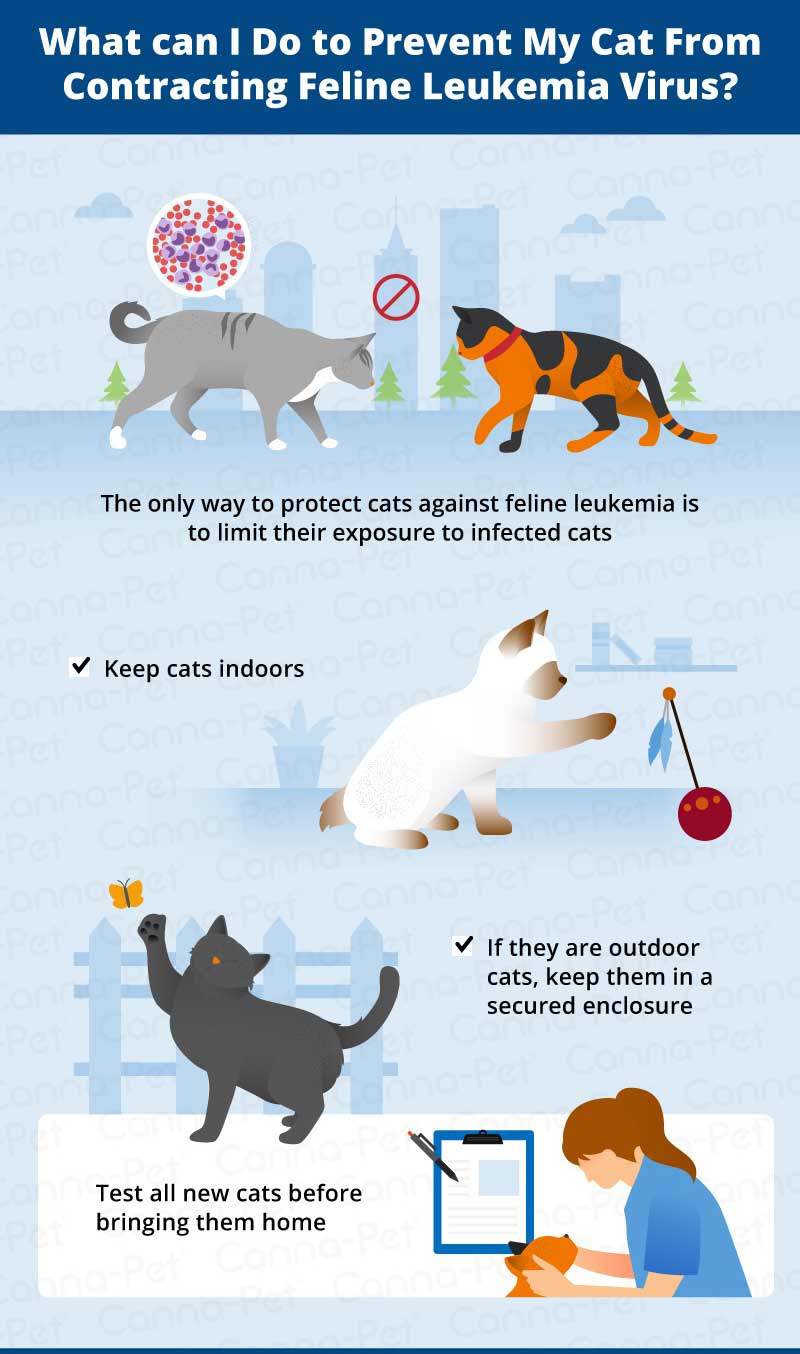
Is there a vaccine available for Feline Leukemia Virus?
Although there is no cure, there is a fairly effective vaccine available for feline leukemia. It does not have a 100 percent success rate and is not considered a core vaccine, but it can be beneficial. Since it does not work for all cats, preventing exposure will remain important even for vaccinated cats. The vaccination also will not cause false positive test results for the ELISA, IFA, or other feline leukemia blood tests.
Many of the available vaccines are a combination of vaccines that also protect against feline herpesvirus (rhinotracheitis), calicivirus, and panleukopenia (FPV). All of the available cat leukemia vaccines have been tested and found safe and effective if they are administered as directed by a veterinarian.
Kittens are generally vaccinated for feline leukemia virus around eight to nine weeks old. They are then given booster vaccinations three or four weeks later, depending on the vaccine. This is followed by boosters every year for as long as they are at risk for exposure. These cats include cats that go outside or live with other cats. If a cat is thought to be at low risk for feline leukemia, a vet may not recommend the vaccination at all.

What is the prognosis for cat leukemia?
When you receive a diagnosis for cat leukemia, you might think the worst, but it is important to remember that cats with feline leukemia virus can live normal lives for long periods of time. Cats that are diagnosed with feline leukemia virus have a median survival time of two and a half years.
Careful monitoring of a cat’s weight, appetite, activity level, elimination habits, appearance of the mouth, eyes, and behavior will be important parts of managing the disease. Consult your veterinarian if any of these signs appear abnormal.
We understand that this may be a difficult time for you and we are here to help you and your pet find any relief that we can. While CBD cannot cure feline leukemia, consider using CBD for cats for its potential benefits to help deal with some of the symptoms of this virus.
Sources:
- “Facts About Feline Leukemia Virus.” WebMD, Accessed 20 March 2017. www.pets.webmd.com/cats/facts-about-feline-leukemia-virus.
- “Cat Leukemia (Feline Leukemia Virus).” PetMD, Accessed 20 March 2017. www.petmd.com/cat/conditions/infectious-parasitic/c_ct_feline_leukemia.
- Kelley, Jane. “9 Things You Should Know About Feline Leukemia.” Catster, 5 June 2015, Accessed 20 March 2017. www.catster.com/lifestyle/cat-health-9-things-feline-leukemia-felv.
- “Feline Leukemia Virus (FeLV).” Pet Health Network, Accessed 20 March 2017. www.pethealthnetwork.com/cat-health/cat-diseases-conditions-a-z/feline-leukemia-virus-felv.
- “The Feline Leukemia Vaccine and Virus.” Vetstreet, Accessed 20 March 2017. www.vetstreet.com/care/feline-leukemia-virus-felv-vaccine.




